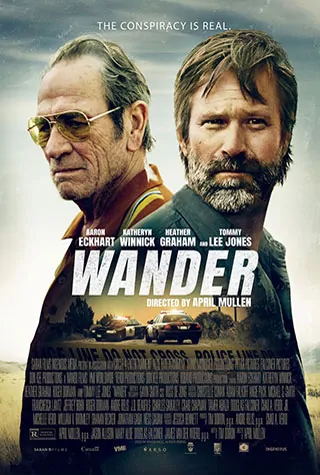| The opening supertext in Wonder calls attention to “indigenous and black people,” “government violences,” “change,” as well as the fact that the film was filmed on the homelands for indigenous peoples. The film was released in 2020, shortly after the Presidential election. It’s tempting to think of this movie in terms of progressive change, and the need to examine power structures and hierarchy. The film opens with a promising shot, the camera following a road through desert scrubland before it arrives at a pickup truck that has overturned. A young woman (Elizabeth Selby from “A Cry in the Night : The Legend of La Llorona”) emerges and begins to run. She meets a mysterious end. From this point, a number of figures inspect the scene and make references to larger events which will be explained later. We are left with even more questions. The opening is a standard and effective one, but it’s used here with less menace and atmosphere than ” Wind River.” April Mullen (Below Her Mouth) leans on the modern Western setting in Tim Doiron’s screenplay. The story focuses on small characters in vast and overwhelming environments. This is reminiscent of ” No Country for Old Men ” and ” Hell or High Water.” Russ De Jong’s and Gavin Smith’s lensing captures this concept well. It includes the narrative which is a neo noir in the vein of “Red Rock West”, “Sicario” and the titular town, whose isolation from the rest of civilization evokes the frontier towns of western myth. Arthur Bretnik, an ex-cop and now private investigator with a tragic past, has arrived in this town. (Though he doesn’t have a drinking problem. Must have missed it at the Cliche Mart.) He is a grizzled former cop, who also happens to be a conspiracy-minded man. Arthur Bretnik is a man on the edge of the world, living in an old trailer in the New Mexico desert in an area called “Middle of Nowhere”. He and his friend Jimmy Cleats, a slightly less insane character (Tommy Lee Jones in “Ad Astra,” another intertextual connection to “No Country for Old Men”), record a podcast about conspiracy theories. Arthur is hired to investigate the death of Zoe Guzman by her mother. The film’s protagonist, Arthur, opens it up to criticisms about the white savior syndrome. In a town where immigrants, indigenous people, and people of colour are threatened, a white authority figure is needed to intervene in order to save the residents. Arthur, who has a limp, is not a hero, as he is mentally unstable and walks with a cane. Arthur’s mental instability is highlighted by the use of hallucinations and flashbacks, which recall the death of his parents as well as an earlier case that he was involved in. The film is reminiscent of Shutter island, and Wander also refers to broader issues such as crime, immigration, government control, and mental health. These elements are treated with lip service, which comes across as laziness rather than interest. If the film was attempting to criticize or unpack white savior, it had to do more than deliver a fairly perfunctory view on mental health. Eckhart is a good actor who portrays someone struggling with reality. He also carries Arthur’s physicality well, with his weighted posture and rolling gait. Heather Graham (Wetlands) is wasted in her role as Shelley Luscomb. She plays Arthur’s friend, and when the plot demands, a lawyer. There is some enjoyment for Batman fans in watching two versions of Harvey Two Face go head-to-head (pun intended). One may wonder if Eckhart and Jones compared notes about such things. The script is not very good for either actor, and Jimmy’s development can be as creaky as some of the doors that are forced open. Katheryn winnick’s performance as Elsa Viceroy (” The Dark Tower“) is the most impressive. She brings mystery and steel to the role, as well the overall film. The visual style of Mullen is almost hysterical. While the convoluted plot may be tolerable, it’s the near-hysterical approach that makes wander unbearable. The camera is almost always moving, starting with the opening tracking shot. This serves more to distract than to engage. The camera will sometimes rush towards a particular location before retreating with equal speed. The device has a narrative purpose, but the other visual tics are meant to repeatedly remind us that ARTHUR is unstable. We understand, yes, but could you please show us, not tell us? The film’s climax could have been tragic, but instead it is a resounding nadir for the narrative and style. It leaves you with the impression that all of what we’ve seen has been rather stupid but done with a seriousness that takes away any sense that it was shlocky. Even though the ending may be full of mirth, you might think that you’re the one who has the last laugh. | |

Wander (2020)
Genre(s): Action, Crime, Mystery, Thriller
MPAA Rating:R
Director(s): April Mullen
Actor(s): Aaron Eckhart, Brendan Fehr, David Gibson, Elizabeth Selby, Heather Graham, Katheryn Winnick, Nicole Steinwedell, Raymond Cruz, Roger Dorman, Tommy Lee Jones
Writer(s): Tim Doiron
Producer(s): April Mullen, Douglas Falconer, Jason Allison, Mary Aloe, Tim Doiron
Studio(s): Saban Films, Aloe Entertainment, Falconer Pictures, Verdi Productions, WANGO Films
Length:94 minutes
Release Date(s):US: December 4, 2020




